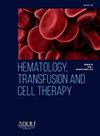VENETOCLAX-BASED VERSUS 7+3 INDUCTION THERAPY IN FIT YOUNGER ADULTS WITH NEWLY DIAGNOSED NON-CBF AML
IF 1.6
Q3 HEMATOLOGY
引用次数: 0
Abstract
Objective
Venetoclax-based regimens have emerged as a standard therapeutic option for newly diagnosed Acute Myeloid Leukemia (AML) in patients deemed unfit for intensive chemotherapy. However, the efficacy of venetoclax in fit patients remains an area of ongoing investigation. Notably, in specific AML subsets, such as Core Binding Factor (CBF) AML, venetoclax-based therapy has demonstrated inferior outcomes compared to intensive chemotherapy. Despite these findings, direct comparative data between venetoclax-based therapies and intensive induction chemotherapy in fit patients with non-CBF AML remains limited. This study aims to evaluate and compare the clinical outcomes of fit younger adult patients with newly diagnosed non-CBF AML who underwent induction therapy with either venetoclax-based regimens or standard 7+3 chemotherapy.
Methodology
This retrospective cohort study included patients assessed at RM Gorbacheva Research Institute for eligibility for Allogeneic Hematopoietic Stem Cell Transplantation (allo-HSCT) from June 2020 to August 2024. Eligible patients were adults with non-CBF AML who received either 7+3 induction chemotherapy or venetoclax in combination with a Hypomethylating Agent (HMA) or Low-Dose Cytarabine (LDAC). Exclusion criteria included age > 60-years and a Hematopoietic Cell Transplantation-Specific Comorbidity Index (HCT-CI) score > 2. To minimize confounding, pairwise propensity score matching was performed based on age, secondary AML status, and ELN 2022 risk classification. Remission in this study referred to Complete Remission (CR), CR with partial or incomplete hematologic recovery, and a morphological leukemia-free state according to the ELN response criteria. Patients who failed to achieve remission after two induction cycles were categorized as refractory. Overall Survival (OS) was defined as the time from start of treatment to death from any cause. Event-Free Survival (EFS) included refractoriness, relapse, or death, with censoring at the last follow-up. Relapse was defined as the reappearance of ≥5% blasts in bone marrow or peripheral blood, or extramedullary disease. Non-Relapse Mortality (NRM) was defined as death in remission. Survival analysis was conducted using the Kaplan-Meier method and log-rank test. Cumulative incidences of relapse and NRM were assessed using competing risk models with Gray’s test. Statistical analyses were performed using R (version 4.4.2). The study adhered to the Declaration of Helsinki and Good Clinical Practice guidelines and was approved by the Pavlov University Ethical Committee.
Results
A total of 112 patients met the inclusion criteria, with 64.3% (n = 72) receiving 7+3 induction and 35.7% (n = 40) treated with venetoclax plus HMA/LDAC. After propensity score matching, each treatment arm included 26 patients. Baseline characteristics of the matched cohort are summarized in Table 1. Remission rates were 73.1% (n = 19) in the 7+3 group and 61.5% (n = 16) in the venetoclax group. Refractory disease was documented in 11.5% (n = 3) and 34.6% (n = 9), respectively. Induction-related mortality occurred in 15.4% (n = 4) of the 7+3 group and 3.8% (n = 1) of the venetoclax group (p = 0.08) (Fig. 1). The median follow-up for surviving patients was 25.5 months (range: 2.5‒37.9). Two-year OS rates were 33.8% (95% CI: 19.6‒58.4) for the 7+3 group and 31.6% (95% CI: 15.1‒66.2) for the venetoclax group (p = 0.7). Two-year EFS was 30.8% (95% CI: 17.3‒54.8) and 31% (95% CI: 16.1‒59.8), respectively (p = 0.8) (Fig. 2). Cumulative relapse incidence was 29% (95% CI: 11‒50) in the 7+3 group and 49% (95% CI: 19‒74) in the venetoclax group (p = 0.28). NRM was significantly higher in the 7+3 group at 38% (95% CI: 18‒58) compared to 5.3% (95% CI: 0.3‒22) in the venetoclax group (p = 0.039) (Fig. 3). The cumulative incidence of allo-HSCT was 46% (95% CI: 26‒64) and 55% (95% CI: 30‒75) for 7+3 and venetoclax groups, respectively (p = 0.15).
Conclusion
In this propensity-matched analysis of fit younger adults with non-CBF AML, venetoclax-based induction therapy demonstrated comparable overall and event-free survival to standard 7+3 chemotherapy. While venetoclax-treated patients exhibited a numerically higher relapse incidence, this difference did not reach statistical significance. Conversely, those receiving 7+3 experienced significantly greater non-relapse mortality. Notably, venetoclax-based therapy was associated with a lower induction-related mortality and a higher rate of refractory disease, underscoring the distinct response dynamics of these regimens. These findings highlight the nuanced risk-benefit profiles of venetoclax and intensive chemotherapy, warranting further prospective validation to optimize patient selection and treatment strategies in fit AML patients.
以venetoclax为基础的7+3诱导治疗对新诊断的非cbf aml的适合年轻成人的影响
目的:even etoclax为基础的方案已经成为新诊断急性髓系白血病(AML)患者不适合强化化疗的标准治疗选择。然而,venetoclax在fit患者中的疗效仍然是一个正在进行的研究领域。值得注意的是,在特定的AML亚群中,如核心结合因子(CBF) AML,与强化化疗相比,venetoclax为基础的治疗显示出较差的结果。尽管有这些发现,在适合的非cbf AML患者中,基于venetoclax的治疗和强化诱导化疗之间的直接比较数据仍然有限。本研究旨在评估和比较新诊断的非cbf AML的合适年轻成年患者的临床结果,这些患者接受了以venetoclax为基础的方案或标准7+3化疗的诱导治疗。方法:本回顾性队列研究纳入了2020年6月至2024年8月在戈尔巴乔夫研究所接受同种异体造血干细胞移植(alloo - hsct)资格评估的患者。符合条件的患者是接受7+3诱导化疗或venetoclax联合低甲基化剂(HMA)或低剂量阿糖胞苷(LDAC)的非cbf AML成人患者。排除标准包括年龄>;60岁和造血细胞移植特异性合并症指数(HCT-CI)评分;2. 为了最大限度地减少混淆,根据年龄、继发性AML状态和ELN 2022风险分类进行两两倾向评分匹配。本研究中的缓解指完全缓解(CR)、部分或完全血液学恢复的CR,以及根据ELN反应标准的形态无白血病状态。在两个诱导周期后未能达到缓解的患者被归类为难治性患者。总生存期(OS)定义为从开始治疗到任何原因死亡的时间。无事件生存期(EFS)包括难治性、复发或死亡,并在最后一次随访时进行审查。复发定义为骨髓或外周血中再次出现≥5%的原细胞,或髓外疾病。非复发死亡率(NRM)定义为缓解期死亡。生存率分析采用Kaplan-Meier法和log-rank检验。累积复发发生率和NRM使用竞争风险模型和Gray检验进行评估。使用R(4.4.2版本)进行统计分析。该研究遵循赫尔辛基宣言和良好临床实践指南,并得到了巴甫洛夫大学伦理委员会的批准。结果112例患者符合纳入标准,其中64.3% (n = 72)接受7+3诱导,35.7% (n = 40)接受venetoclax联合HMA/LDAC。倾向评分匹配后,每个治疗组包括26例患者。表1总结了匹配队列的基线特征。7+3组缓解率为73.1% (n = 19),venetoclax组缓解率为61.5% (n = 16)。难治性疾病分别为11.5% (n = 3)和34.6% (n = 9)。7+3组诱导相关死亡率为15.4% (n = 4),venetoclax组为3.8% (n = 1)(p = 0.08)(图1)。存活患者的中位随访时间为25.5个月(范围:2.5-37.9)。7+3组的两年OS率为33.8% (95% CI: 19.6-58.4), venetoclax组的两年OS率为31.6% (95% CI: 15.1-66.2) (p = 0.7)。2年EFS分别为30.8% (95% CI: 17.3-54.8)和31% (95% CI: 16.1-59.8) (p = 0.8)(图2)。7+3组的累积复发率为29% (95% CI: 11-50), venetoclax组为49% (95% CI: 19-74) (p = 0.28)。与venetoclax组的5.3% (95% CI: 0.3-22)相比,7+3组的NRM明显更高,为38% (95% CI: 18-58) (p = 0.039)(图3)。7+3组和venetoclax组的alloo - hsct累积发生率分别为46% (95% CI: 26-64)和55% (95% CI: 30-75) (p = 0.15)。结论:在这项针对非cbf型AML的适合年轻成人的倾向匹配分析中,基于venetoclax的诱导治疗显示出与标准7+3化疗相当的总生存率和无事件生存率。虽然venetoclax治疗的患者在数字上表现出更高的复发率,但这种差异没有达到统计学意义。相反,接受7+3治疗的患者的非复发死亡率明显更高。值得注意的是,基于venetoclax的治疗与较低的诱导相关死亡率和较高的难治性疾病发生率相关,强调了这些方案的独特反应动力学。这些发现强调了venetoclax和强化化疗的微妙风险-收益特征,需要进一步的前瞻性验证,以优化适合AML患者的患者选择和治疗策略。
本文章由计算机程序翻译,如有差异,请以英文原文为准。
求助全文
约1分钟内获得全文
求助全文
来源期刊

Hematology, Transfusion and Cell Therapy
Multiple-
CiteScore
2.40
自引率
4.80%
发文量
1419
审稿时长
30 weeks
 求助内容:
求助内容: 应助结果提醒方式:
应助结果提醒方式:


